Defenses for Fall 2023
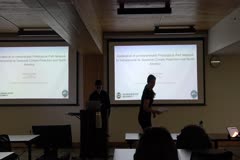
Application of an Interpretable Prototypical-Part Network for Subseasonal-to-Seasonal Climate Prediction over North America
December 13, 2023
Nicolas Gordillo
In recent years, the use of neural networks for weather and climate prediction has greatly increased. In order to explain the decision-making process of machine learning “black-box” models, most research has focused on the use of machine learning explainability methods (XAI). These methods attempt to explain the decision making process of the black box networks after they have been trained.…

Effects of Land Surface-Atmosphere Interactions Within Two Convective Storm Regimes
December 04, 2023
Ben Ascher
Convective storms, which are driven in part by atmospheric thermodynamic instability, come in a range of shapes and sizes and bring a variety of impacts both at the surface and throughout the atmosphere. Often these storms initiate as a result of lifting within the Planetary Boundary Layer (PBL), the behavior of which is strongly affected by the characteristics of the land surface below them.…
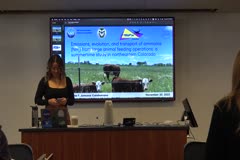
Emissions, evolution, and transport of ammonia (NH3) from large animal feeding operations: a summertime study in northeastern Colorado
November 30, 2023
Julieta Juncosa Calahorrano
The Transport and Transformation of Ammonia (TRANS2Am) airborne field campaign occurred over northeastern Colorado during the summers of 2021 and 2022. TRANS2Am measured ammonia (NH3) emissions from cattle feedlots and dairies with the goal of describing the near-field evolution of the NH3 emitted from animal feeding operations. Most of the animal husbandry facilities in Colorado are…
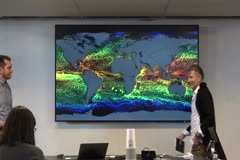
The Influence of Western Boundary Currents on Tropospheric Climate Variability in Reanalyses and Climate Models
November 29, 2023
James Larson
Oceanic western boundary currents play a crucial role in transporting heat poleward, thereby influencing the midlatitude climatological-mean climate and serving as an important component for midlatitude storm tracks that provide rainfall to land regions. Yet, what is still left to be determined is what role these oceanic currents play in influencing atmospheric variability. Characterized by the…
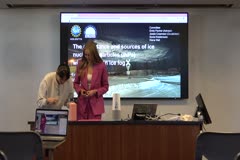
The abundance and sources of ice nucleating particles (INPs) within Alaskan ice fog
November 28, 2023
Emily Lill
Fairbanks, Alaska often experiences low visibility due to air pollution. Low wind speeds and strong temperature inversions paired with local emissions from burning of wood, oil, gasoline, and coal lead to wintertime pollution events where concentrations of fine particulate matter (PM2.5) often reach 50 μg m−3, exceeding the Environmental Protection Agency (EPA) 24-hour National Ambient Air…
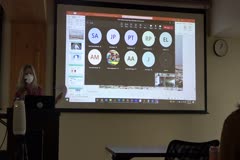
Ice Nucleating Particles in the Arctic: Measurement and Source Tracking
November 06, 2023
Kevin Barry
The Arctic landscape is dynamic, with sea ice melting and permafrost thawing. Its near-surface air temperature is warming 3.8 times faster than other regions. This is known as Arctic amplification. Clouds affect this level of amplification, and their phase is important for determining the surface energy budget. Arctic mixed-phase clouds can last for several days but are not represented well in…
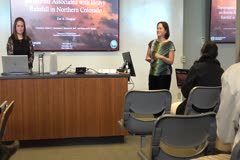
TOPOGRAPHIC AND DIURNAL INFLUENCES ON STORMS ASSOCIATED WITH HEAVY RAINFALL IN NORTHERN COLORADO
November 01, 2023
Zoe Douglas
Despite its profound impacts on agricultural and socioeconomical conditions globally, heavy rainfall is a high-impact weather phenomenon of which we have limited quantitative understanding and forecast skill. The Prediction of Rainfall Extremes Campaign in the Pacific (PRECIP) planned to observe the spectrum of heavy rainfall events in the moisture-rich environment of Taiwan and Japan during…
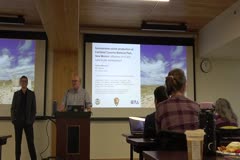
Summertime ozone production at Carlsbad Caverns National Park, New Mexico: influence of oil and natural gas development
October 19, 2023
Andrey Marsavin
Southeastern New Mexico’s Carlsbad Caverns National Park (CAVE) has increasingly seen summer ground-level ozone (O3) levels surpassing the US Environmental Protection Agency’s National Ambient Air Quality Standard (NAAQS) of 70 parts per billion by volume (ppbv). The park is located in the western part of the Permian oil and natural gas (O&G) basin, where production rates have more than…

Marine ice nucleating particles: sources, composition, emissions, and model parameterizations
October 16, 2023
Kathryn Moore
Sea spray aerosol has received increasing attention over the last decade as a source of ice nucleating particles (INPs) to the atmosphere. Sparse measurements in remote marine regions indicate both marine INP concentrations and ice nucleating efficiency are several orders of magnitude lower than those of mineral or soil dusts, which dominate the INP budget on a global scale. The Southern Ocean…
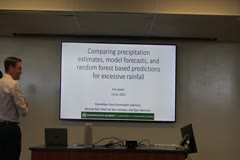
Comparing precipitation estimates, model forecasts, and random forest based predictions for excessive rainfall
October 13, 2023
Eric James
Flash flooding is an important societal challenge, and improved tools are needed for both real-time analysis and short-range forecasts. We present an evaluation of threshold exceedances of quantitative precipitation estimate (QPE) and forecast (QPF) datasets in terms of their degree of correspondence with observed flash flood events over a seven-year period. We find that major uncertainties…
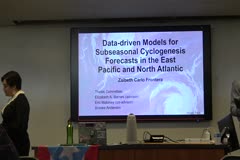
Data-driven Models for Subseasonal Cyclogenesis Forecasts in the East Pacific and North Atlantic
October 06, 2023
Zaibeth Carlo-Frontera
Tropical cyclones (TCs) are hazardous and financially burdensome meteorological events. Previous studies have revealed that longer timescale phenomena, including the El Niño Southern Oscillation (ENSO), the Madden-Julian Oscillation (MJO), and African Easterly Waves, influence TC development by modifying large-scale environmental conditions such as vertical wind shear, mid-level moisture, and…
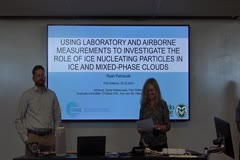
USING LABORATORY AND AIRBORNE MEASUREMENTS TO INVESTIGATE THE ROLE OF ICE NUCLEATING PARTICLES IN ICE AND MIXED-PHASE CLOUDS
September 25, 2023
Ryan Patnaude
Ice may be present in the atmosphere either in cirrus or mixed-phase cloud regions, each with their own distinctly different characteristics and formation mechanisms. The former is characterized by the presence of only ice crystals at temperatures < -38 ºC, while the latter includes the coexistence of both supercooled liquid cloud droplets and ice crystals between temperatures of 0 ºC and…
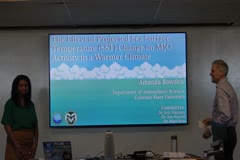
THE EFFECT OF PROJECTED SEA SURFACE TEMPERATURE CHANGE ON MJO ACTIVITY IN A WARMER CLIMATE
September 22, 2023
Amanda Bowden
The Madden Julian Oscillation (MJO) consists of a convective region that propagates eastward in the tropics on repeat every 30-90 days with peak amplitude during the Boreal Winter (November - March). Since the MJO modulates extreme weather, future MJO changes in a warmer climate have implications for prediction of extreme events. Understanding precipitation pattern changes in a changing…
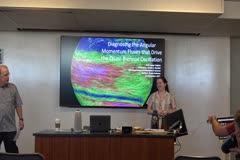
Diagnosing the Angular Momentum Fluxes that Drive the Quasi-Biennial Oscillation
September 12, 2023
Ann Casey Hughes
The quasi-biennial oscillation (QBO) is one of the most amazing phenomena in the atmosphere. It is a descending pattern of alternating easterly and westerly equatorial stratospheric winds that is produced by the upward transport of momentum in multiple types of atmospheric waves. The discovery of the QBO and its role in the global circulation are discussed. The angular momentum budget of the…
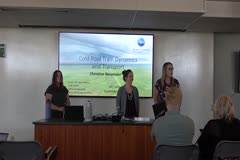
Cold Pool Train Dynamics and Transport
September 08, 2023
Christine Neumaier
Convectively generated cold air outflows, referred to as cold pools, can initiate new convection and loft aerosols, such as dust or pollen. In the BioAerosols and Convective Storms Phase I (BACS-I) field campaign, we observed multiple cold pools passing over the same location on the same day, without colliding, which we refer to as a “cold pool train”. The goals of this study are to examine…
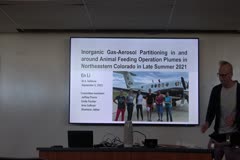
Inorganic Gas-Aerosol Partitioning in and around Animal Feeding Operation Plumes in Northeastern Colorado in Late Summer 2021
September 05, 2023
En Li
Ammonia (NH3) from animal feeding operations (AFOs) is an increasingly important source of reactive nitrogen in the US, but despite its ramifications to air quality and human and ecosystem health, its near-source evolution remains understudied. To this end, the Transport and Transformation of Ammonia (TRANS2Am) field campaign was conducted in the northeastern Colorado Front Range in summer 2021…
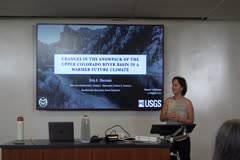
CHANGES IN THE SNOWPACK OF THE UPPER COLORADO RIVER BASIN IN A WARMER FUTURE CLIMATE
August 23, 2023
Lexi Sherman
Water is a crucial factor to sustaining life on Earth. Snow acts as a reservoir for water, providing storage during the cold seasons and freshwater resources throughout the warmer months. Streamflow in the upper Colorado River Basin is primarily contributed by seasonal mountain snowmelt that provides critical freshwater resources to humans and wildlife, effectively connecting ecological,…
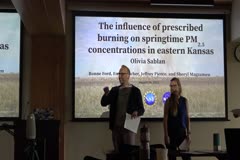
The influence of prescribed burning on springtime PM2.5 concentrations in eastern Kansas
August 18, 2023
Olivia Sablan
Annual springtime (March - May) prescribed burning is practiced in the Flint Hills of eastern Kansas to mitigate wildfire risk, improve nutritional value of vegetation for cattle grazing, limit woody encroachment, and maintain the health of the tall grass prairie ecosystem. Smoke from these prescribed fires produces fine particulate matter (PM2.5), degrading air quality. Smoke from prescribed…
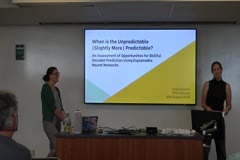
When is the Unpredictable (slightly more) Predictable? An Assessment of Opportunities for Skillful Decadal Climate Prediction Using Explainable Neural Networks
August 10, 2023
Emily Gordon
Predicting climate variability on decadal (2-10 year) timescales can have huge implications for society because it can provide better estimates of both global trends as well as regional climate variability for crucial, actionable lead times. The key to skillful decadal prediction is understanding and predicting oceanic variability. However, predictable sig- nals in the ocean can be masked by…
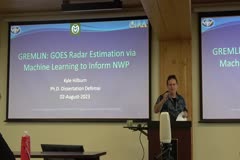
GREMLIN: GOES Radar Estimation via Machine Learning to Inform NWP
August 02, 2023
Kyle Hilburn
Imagery from the Geostationary Operational Environmental Satellite (GOES) has been a key element of U.S. operational weather forecasting since 1975. The latest generation, the GOES-R Series, offers new capabilities to support the need for high-resolution rapidly refreshing imagery for situational awareness. Despite the well demonstrated value to human forecasters, usage of GOES imagery in data…
